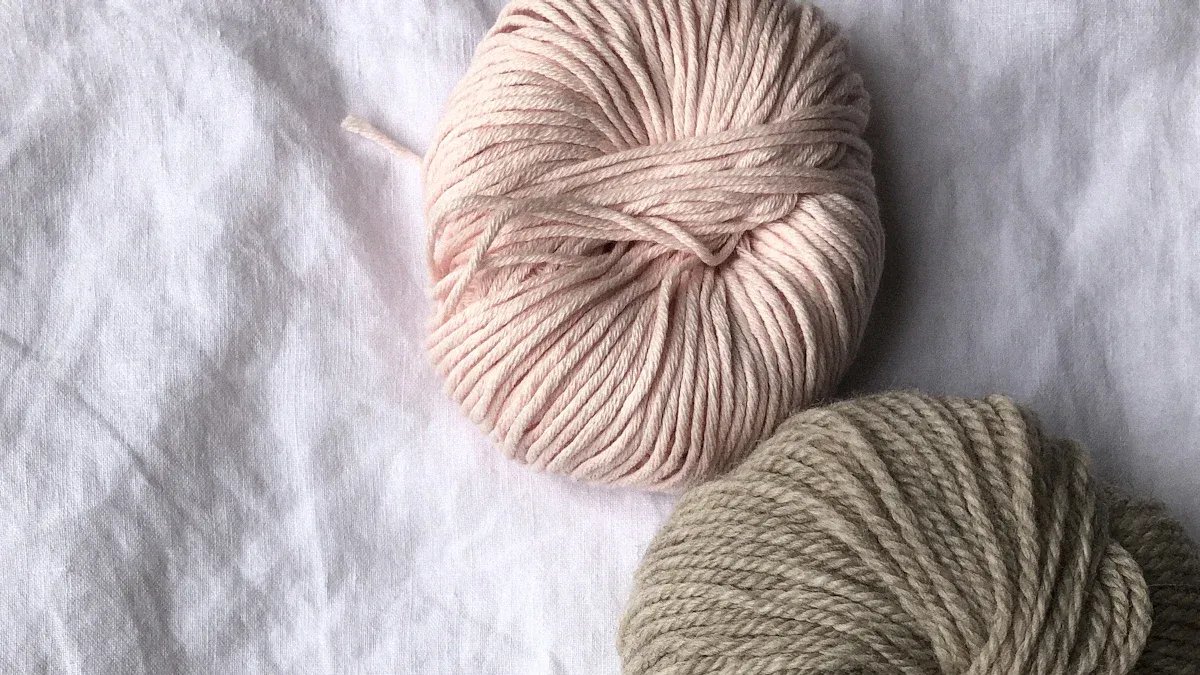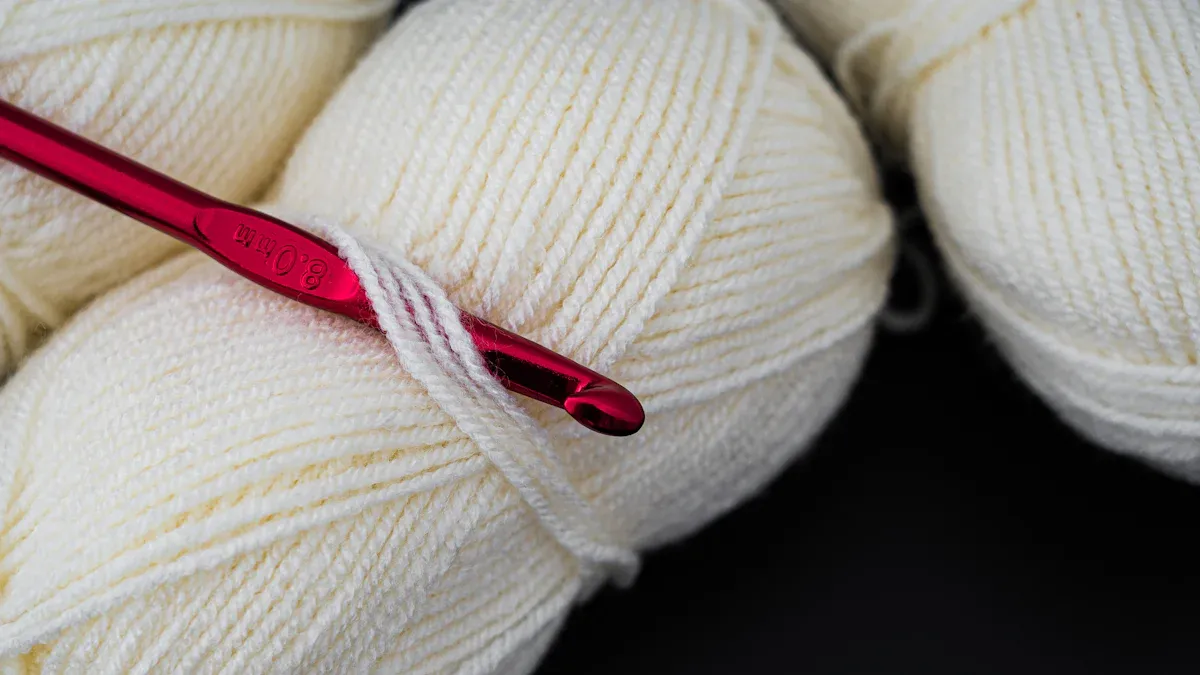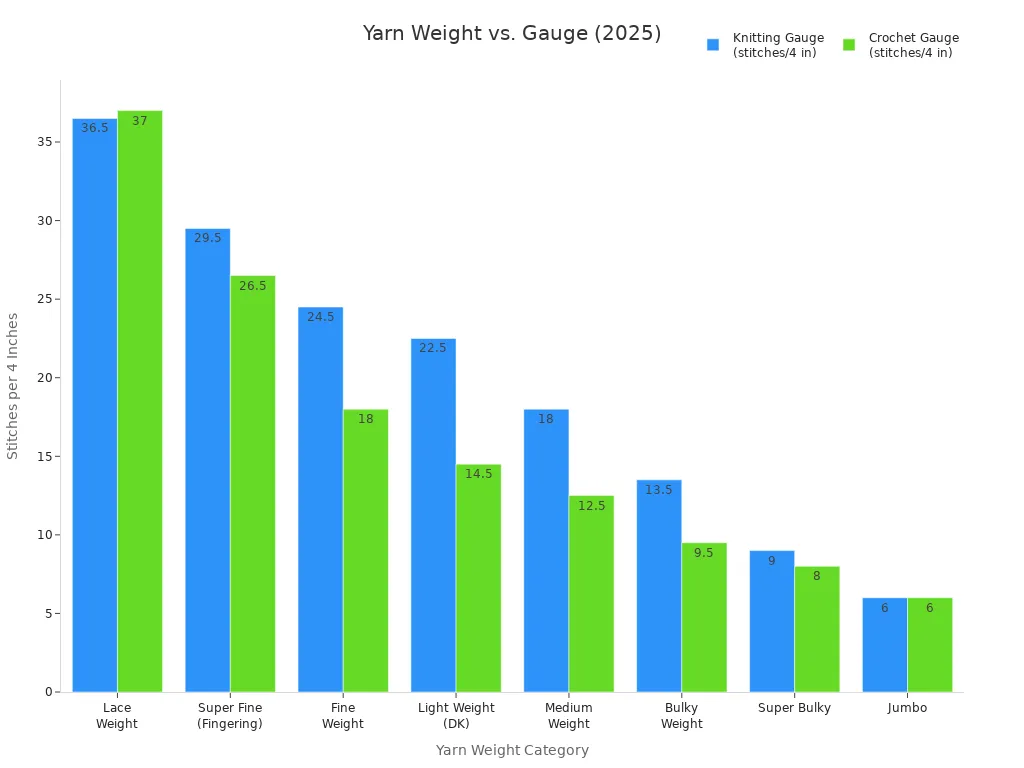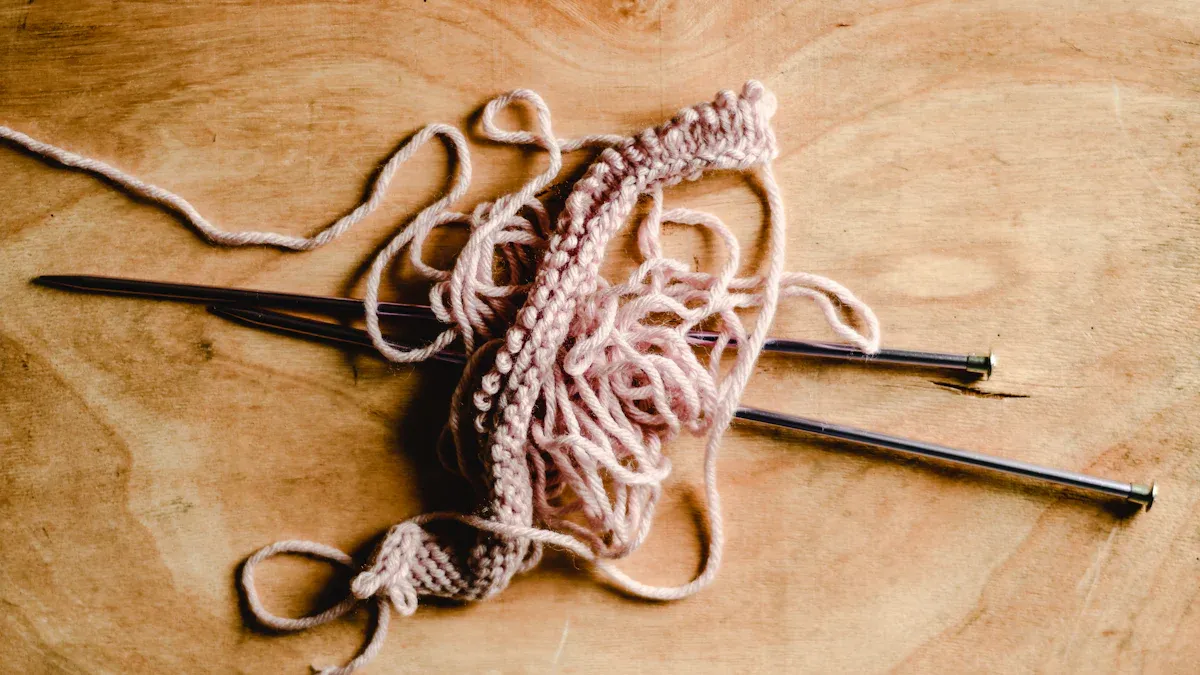
Picking the best quality yarn for knitting starts with knowing what you want your project to feel and look like. You should match fiber, weight, ply, durability, softness, and care to your knitting project. The global knitting yarn market is growing fast. New colors and eco-friendly options are very popular now:
Metric | Value |
|---|---|
$4.7 billion | |
Projected size in 2025 | $4.91 billion |
Expected CAGR (2025-2033) | 4.5% |
You can find chunky yarns, bold color trends, and sustainable fibers everywhere now. When you pick yarn for knitting, think about things like fiber innovations, color, and your skill level. Let your creativity shine as you look for the best quality yarn for knitting.
Key Takeaways
Match your yarn choice to your project by considering fiber, weight, softness, and care needs for the best results.
Choose yarn fibers wisely: natural fibers feel soft and breathe well, synthetics are easy to care for, and blends offer the best of both.
Pick the right yarn weight to fit your pattern and project type; worsted weight is great for beginners and many projects.
Follow care instructions on yarn labels to keep your knitting looking great and lasting longer.
Explore new 2025 trends like eco-friendly fibers and bold colors to make your knitting stylish and sustainable.
Choose Yarn for Knitting Projects
Identify Project Needs
When you choose yarn for knitting, start by thinking about what you want to make. Every knitting project has its own needs. Garments like sweaters or summer tops need yarns that feel soft, drape well, and keep you comfortable. Accessories such as scarves or hats work best with yarns that are warm and cozy. Home décor items, like pillows or rugs, need yarns that are strong and easy to clean.
Here’s a quick guide to help you match yarn to your project:
Project Type | Best Yarn Fiber(s) | Yarn Weight Range | What to Look For |
|---|---|---|---|
Baby Blankets | Acrylic, Superwash Merino | Medium, Light | Soft, easy care, hypoallergenic |
Scarves & Shawls | Merino, Alpaca/Silk blends | Fingering to Worsted | Warmth, softness, drape |
Winter Sweaters | Wool, Wool Blends | DK to Worsted | Insulation, elasticity, durability |
Summer Tops | Cotton, Cotton Blends | Sport to DK | Breathability, structure, coolness |
Pillows | Cotton, Cotton Blends | Worsted to Bulky | Durability, stitch definition |
Rugs | Wool, Jute/Cotton Blends | Bulky to Super Bulky | Durability, shape retention |
If you’re new to knitting, worsted yarn is your best friend. It’s easy to see your stitches, and it works well for most patterns. Light solid colors help you spot mistakes and learn faster. Avoid novelty yarns until you feel more confident.
Tip: Worsted yarn in skeins or balls is easier to handle than hanks. Practice with affordable yarn before trying luxury fibers.
Consider Season and Use
Season matters a lot when you choose yarn for knitting. For summer knitting, pick lightweight yarns made from cotton, linen, or bamboo. These fibers feel cool and let your skin breathe. Summer tops and lightweight knitting projects look great in these yarns. If you love summer knitting patterns, stick with sport or DK weight for the best results.
For winter, wool and wool blends keep you warm. Worsted and bulky yarns make cozy sweaters and thick tops. If you want to knit lightweight tops for cooler days, try blends that mix wool with plant fibers. These give you warmth without feeling heavy.
Lightweight yarns are perfect for summer tops and summer knitting.
Worsted yarn is great for beginners and works for many patterns.
Think about how often you’ll use or wash your project. Easy-care yarns like acrylic or superwash wool are perfect for busy families.
When you choose yarn for knitting, always match the yarn’s weight and fiber to your project’s needs. This is one of the most important factors to consider when purchasing yarn. You’ll get the best results and enjoy every stitch.
Best Quality Yarn for Knitting

To pick the best yarn in 2025, you need to think about more than just color or price. You want your project to last a long time, feel nice, and look great. Let’s talk about what makes yarn special, so you can choose the right one for every project.
Fiber Content
The fiber in your yarn changes how it feels, how warm it is, how long it lasts, and how you care for it. There are three main kinds of yarn: natural, synthetic, and blended. Each kind has good and bad points.
Fiber Type | Advantages | Disadvantages |
|---|---|---|
Warm and soft; stretches naturally; good for the earth | Can cause allergies; needs gentle washing; can shrink or felt | |
Acrylic (Synthetic) | Easy to wash and strong; does not cause allergies; cheap | Not great for the planet; does not breathe well; can feel hot |
Natural fibers like wool, cotton, and silk are comfy, let air through, and feel nice to touch. They are also good for the earth because they break down over time. Wool, like merino and cashmere, is soft and warm. Merino is known for being gentle, and cashmere is very fancy and warm. These fibers make your knitting feel special, but they need gentle care and can cost more money.
Synthetic fibers, like acrylic and polyester, are cheap and easy to wash. They are good for busy people or anyone who wants easy-care projects. But they do not let air through as well and can feel less comfy, especially when it is hot. Blended yarns mix the best parts of both types. You get the softness of merino or cashmere and the strength and easy care of synthetics. Blended yarns are smart for socks, sweaters, and things for your home.
If you care about the earth, you will like the new green yarns in 2025. Look for organic cotton, recycled wool, hemp, bamboo, and alpaca. These use less water, fewer chemicals, and often come from good sources. Brands like Blue Sky Fibers, Malabrigo, and La Bien Aimée have high-quality skeins made with earth-friendly fibers.
Tip: Always check the yarn label for fiber content and look for special certifications like GRS or OEKO-TEX® for extra safety.
Yarn Weight
Yarn weight tells you if the yarn is thick or thin. This changes how your knitting looks and feels. The right weight helps you get the best stitches, drape, and fit for your project.
Here’s a simple yarn weight guide for 2025:
Yarn Weight Category | Numeric Weight | Typical Uses | Recommended Knitting Needle Size (US) | Common Knitting Gauge (stitches/4 inches) |
|---|---|---|---|---|
Lace Weight | 0 | Shawls, wraps, lacy work | 000-1 (1.5mm-2.25mm) | 33-40 (stockinette) |
Super Fine (Fingering or Sock) | 1 | Socks, shawls, baby and adult clothes, accessories | 1-3 (2.25mm-3.25mm) | 27-32 (stockinette) |
Fine Weight (Sport) | 2 | Colorwork, textured fabric, cables, socks, sweaters | 3-5 (3.25mm-3.75mm) | 23-26 (stockinette) |
Light Weight (DK) | 3 | Sweaters, accessories, kids’ clothes | 5-7 (3.75mm-4.5mm) | 21-24 (stockinette) |
Medium Weight (Worsted, Aran) | 4 | Clothes, accessories, home items, beginner projects | 7-9 (4.5mm-5.5mm) | 16-20 (stockinette) |
Bulky Weight | 5 | Heavy sweaters, rugs, throws | 9-11 (5.5mm-8mm) | 12-15 (stockinette) |
Super Bulky | 6 | Cowls, scarves, hats | 11-17 (8mm-12.75mm) | 7-11 (stockinette) |
Jumbo | 7 | Big stitch projects, arm knitting, blankets | 17 and up (15mm and up) | 6 or fewer (stockinette) |

Light yarns, like lace or fingering, make thin, light fabrics that drape nicely. These are great for shawls, baby clothes, and summer tops. Worsted and medium weights make strong, soft, and tough fabrics with clear stitches. Bulky and super bulky yarns make thick, warm projects like hats and blankets, but the stitches are not as clear.
Note: Always check your pattern for the right yarn weight and match it to your yarn for the best results.
Ply and Construction
How yarn is made—its ply and construction—changes how your knitting feels and how long it lasts. Plied yarns twist two or more strands together. More plies mean the yarn is stronger and stretches more. For example, a 3-ply merino yarn is stronger and pills less than a single-ply cashmere.
Chainette yarns look like tiny tubes. They are light and stretchy, so your projects feel soft and bouncy. Tube yarns are fluffy and do not pill much, while air-jet spun yarns are strong and soft. These new ways of making yarn help your knitting keep its shape and look new for longer.
If you want your fabric to bounce back, pick a yarn with more plies and a tighter twist. For a soft, drapey scarf, use yarn with fewer plies and a looser twist. The right construction helps you get the look and feel you want.
Tip: Try different yarn constructions to see which one gives you the best stitches and drape for your project.
Softness and Comfort
You want your knitting to feel nice on your skin. The softest fibers in 2025 are organic cotton, bamboo, TENCEL™, silk, and very fine merino wool. Cashmere and alpaca are also great for softness and warmth. These fibers are gentle, let air through, and are good for sensitive skin.
To test softness, use your hands. Squeeze the skein, rub it on your cheek, and see how it feels. You can also wash a small piece in warm water to make the fibers softer. Some knitters soak yarn in watered-down hair conditioner or use steam to make it fluffier.
Note: How tight you knit changes softness. Loose stitches make a softer fabric, while tight stitches feel stiffer.
Luxury fibers like cashmere, silk, and alpaca make your projects feel extra special. Merino wool is a favorite because it is gentle and soft. If you have sensitive skin, use these fibers and stay away from rough yarns.
Durability and Care
Durability is important if you want your knitting to last. Wool, especially merino and cashmere, is warm and stretchy but can shrink or felt if washed wrong. Superwash wool is treated so you can wash it in a machine, which makes it easier to care for. Plant fibers like cotton and linen are strong and get softer as you use them. Synthetic fibers like acrylic and polyester are tough, easy to wash, and do not wear out fast.
Here’s a quick yarn material guide for care:
Yarn Fiber Type | Characteristics | Durability | Care Requirements | Typical Uses |
|---|---|---|---|---|
Animal Fibers (Wool, Alpaca, Mohair, Silk) | Warm, stretchy, keeps heat in; soft to shiny | Medium to high, but can felt or stretch | Usually hand wash; superwash wool can go in the machine | Cold-weather clothes, fancy items, scarves, sweaters |
Plant Fibers (Cotton, Linen, Bamboo, Hemp) | Let air through, strong, get softer with use | Strong, can get softer over time | Usually machine washable; some need gentle cycles | Summer clothes, home items, baby things |
Synthetic Fibers (Acrylic, Polyester, Nylon) | Light, strong, cheap, stretchy | Very strong, do not wear out fast | Machine washable and dryable; easy care | Cheap projects, socks, outdoor things |
Blended Yarns (Wool-Nylon, Wool-Acrylic, Cotton-Polyester) | Mix warmth, stretch, strength, and easy care | Stronger and stretchier than pure fibers | Often machine washable; easier care than animal fibers | Socks, sweaters, many kinds of clothes |
For easy care, pick yarns you can wash in a machine, like superwash wool, cotton, or acrylic. Hand wash delicate fibers like cashmere, silk, and alpaca. Always dry your knitting flat to keep its shape.
Tip: If you are not sure, follow the care instructions on the yarn label. This keeps your projects looking great.
2025 Trends: Sustainability, Color, and Innovation
In 2025, the best yarn is all about being green and stylish. Earth-friendly fibers like organic cotton, recycled wool, hemp, bamboo, and alpaca are everywhere. Brands use new ways to dye yarn with less water and make less waste. New yarns made from plants and recycled polyester help the planet.
Color trends are about earthy shades and bright pops of color. Pantone’s Color of the Year, ‘Mocha Mousse,’ is a calm brown that looks good with natural colors. Other popular colors are Solar Flare, Cool Current, Meadow Fog, Hibiscus Punch, and Sun-Bleached Clay. Yarn colors mix these earthy and bright shades for a modern style.
Yarn in 2025 is also smarter. There are smart textiles, seamless knitting, and AI-powered machines for perfect stitches. You will find skeins that stretch better, last longer, and feel softer. These new ideas help you make soft and strong projects that last.
Note: The best yarn for knitting has the right fiber, weight, construction, and color for your project. Use this yarn material guide and yarn weight guide to help you pick.
Best Yarn for Every Project
Choosing the best yarn for every project can feel tricky, but you can make it simple by matching fiber, weight, and care to what you want to knit. Here’s a quick guide to help you pick the best yarn for sweaters, socks, scarves, baby items, and home décor. You’ll also see how color and yarn color combinations can make your patterns pop!
Recommended Fiber Types | Yarn Weight | Key Considerations | |
|---|---|---|---|
Sweaters & Cardigans | Wool, alpaca, cashmere | Worsted, bulky | Warmth, elasticity, insulation, color depth |
Socks & Accessories | Merino wool with nylon blends | Super fine, sport | Durability, stretch, machine washable |
Scarves & Shawls | Merino, alpaca, silk, bamboo blends | Fingering, DK | Softness, drape, color vibrancy |
Baby & Kids | Superwash wool, cotton, bamboo blends | DK, sport | Softness, hypoallergenic, easy care |
Home Décor | Cotton, acrylic, blends, jute | Bulky, super bulky | Durability, easy care, bold color options |
Sweaters and Cardigans
You want your tops to feel cozy and last a long time. Wool, alpaca, and cashmere give warmth and stretch. Choose worsted or bulky yarn for thick, comfy sweaters. Look for rich color choices to match your style. Patterns with cables or texture show up best in solid or heathered shades.
Socks and Accessories
Socks need yarn that can handle lots of wear. Merino wool with a bit of nylon works great. Super fine or sport weight yarn gives a snug fit. Pick machine-washable options for easy care. Try bright color combinations to make your socks and hats stand out.
Scarves and Shawls
Scarves and shawls let you play with color and drape. Merino, alpaca, silk, or bamboo blends feel soft and show off patterns. Fingering or DK weight yarn makes lightweight wraps. Choose yarn color combinations that highlight lace or stripes.
Baby and Kids
For baby and kids’ knitting, softness and safety matter most. Superwash wool, cotton, and bamboo blends feel gentle on skin. DK or sport weight yarn works well for tops and blankets. Always check for easy-care labels so parents can wash items often.
Look for hypoallergenic fibers.
Avoid scratchy or rough yarn.
Pick fun, cheerful colors for kids’ patterns.
Home Décor
Home décor projects need strong yarn. Cotton and acrylic are easy to wash and keep their color. Bulky or super bulky yarn makes sturdy pillows, rugs, and baskets. Try bold color blocks or textured patterns for a modern look.
Tip: Always check yarn labels for care instructions and fiber content. This helps your knitting last longer and keeps colors bright.
Knitting Mistakes to Avoid

Even experienced knitters can run into trouble if they skip a few important steps. Here are some common mistakes you’ll want to avoid when choosing yarn and starting your next knitting project.
Ignoring Care Instructions
You might feel excited to finish your project, but don’t forget to check the care label on your yarn. If you ignore these instructions, your finished piece could shrink, stretch, or lose its shape. For example, tumble drying a wool sweater can ruin the fibers and make it unwearable. Always lay your knitting flat to dry and follow the label’s advice. This simple habit keeps your handmade items looking great for years.
Tip: Keep yarn labels until your project is done so you always have the care info handy.
Mismatching Yarn Weight
Choosing the wrong yarn weight for your pattern can cause big problems. If you use a yarn that’s too thick or too thin, your project might turn out the wrong size or shape. Always match the yarn weight to what your pattern suggests. Check the wraps per inch (WPI) and compare it to the recommended yarn. Pay attention to fiber content and construction, since these also affect how your knitting looks and feels.
Underestimating Yardage
Running out of yarn in the middle of a project is frustrating. To avoid this, estimate how much yarn you’ll need before you start. Look at your pattern for yardage suggestions, and always buy a little extra for swatching or fixing mistakes. If you’re mixing yarns from different sources, check dye lots and compare skeins side by side to keep color and texture consistent.
Measure your project’s size and check your gauge.
Add extra yarn for cables, lace, or colorwork.
Round up when buying to avoid shortages.
Overlooking Gauge and Needle Size
Skipping a gauge swatch is one of the most common mistakes in knitting. If your stitches don’t match the pattern’s gauge, your project might not fit. Always knit a swatch with your chosen yarn and needles, then wash and measure it. Adjust your needle size if needed. Try different needle materials if you can’t get the right gauge. Consistent swatching helps your finished piece turn out just right.
Remember: Taking time to check gauge and needle size saves you from disappointment later.
Choosing the best yarn in 2025 means thinking about your project’s needs, fiber type, yarn weight, and color. Here’s a quick checklist to help you:
Know what your project needs—think about stretch, softness, and care.
Match fiber content and construction for the right look and feel.
Swatch and check your gauge for a perfect fit.
Stay updated with new trends like recycled yarns and bold colors.
Don’t be afraid to try new textures or techniques. You’ll find more joy and creativity in every stitch!
FAQ
What yarn is best for beginners in 2025?
You should start with worsted weight yarn. It’s easy to see your stitches and works well for most patterns. Choose light, solid colors. Avoid fuzzy or novelty yarns until you feel more confident.
How do I know if a yarn is eco-friendly?
Look for labels like “organic,” “recycled,” or certifications such as GRS or OEKO-TEX®. Many brands now highlight sustainable practices. You can also check the company’s website for details about their yarn’s environmental impact.
Can I mix different yarn brands in one project?
You can, but check that the yarns have the same weight, fiber content, and care instructions. Always knit a swatch first. This helps you see if the yarns work well together and keeps your project looking great.
What’s the easiest way to care for hand-knit items?
Always follow the yarn label. Most knits need gentle washing and flat drying. Superwash wool and acrylic are machine washable. Delicate fibers like cashmere or silk need hand washing. Keep your knits out of the dryer to avoid shrinking.
How do I pick colors that look good together?
Try using a color wheel or look at trending palettes for 2025. Earthy tones and bright pops work well together. Lay your yarns side by side in natural light. Trust your eye and have fun with color!









